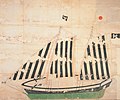Yamaguchi Prefectural Archives
| Yamaguchi Prefectural Archives 山口県文書館 | |
|---|---|
 Yamaguchi Prefectural Library | |
 | |
| 34°10′54″N 131°28′35″E / 34.181540°N 131.476307°E | |
| Location | 150-1 Ushirogawara, Yamaguchi |
| Established | April 1959 |
| Collection size | 530,000[1] |
| Building information | |
| Building | Yamaguchi Prefectural Library 山口県立山口図書館 |
| Website | Official website (ja) |
Yamaguchi Prefectural Archives (山口県文書館, Yamaguchi-ken Monjo-kan) opened in Yamaguchi, Yamaguchi Prefecture, Japan, in 1959 as the country's first dedicated modern archival institution.[2][3][4]
History
[edit]In Shōwa 27 (1952), the Mōri family, former daimyō of Chōshū Domain, deposited its domainal documents with Yamaguchi Prefecture, whereupon they were stored, alongside materials gathered by the pre-war Prefectural History Compilation Office, at Yamaguchi Prefectural Library (ja).[5] These items were transferred in with the opening of Yamaguchi Prefectural Archives in 1959; donations and deposits - including materials from the Tokuyama Domain Mōri family - have continued since.[5]
Holdings
[edit]The archives holds approximately 530,000 documents, roughly divided into five groups:[1]
- Domain documents, including:
- Mōri Family Library (毛利家文庫)
- Tokuyama Mōri Family Library (徳山毛利家文庫)
- Prefectural Government's Old Clan Records (県庁伝来旧藩記録)
- Administrative documents, from the Meiji era onwards
- Administrative materials, from the Meiji era onwards
- Publications, photographs, films, audio recordings, etc.
- Family documents, including:
- Corporation, foundation, and family documents, including those of Edo period samurai houses
- Special library
- Textbooks, newspapers, etc.
Cultural Properties
[edit]The holdings include seven Important Cultural Properties, two Prefectural Cultural Properties, and three Municipal Tangible Cultural Properties.[6]
Important Cultural Properties
[edit]- Arimitsu Family Documents (有光家文書・長門国正吉郷入江塩浜絵図): 121 items, dating from the Kamakura period to the Edo period, together with a map of the Nagato Province Masayoshi Irie Salt Fields[7][8]
- Kumagaya Family Documents (熊谷家文書(二百五十五通)): 255 documents mounted as 13 scrolls, dating from the Kamakura period to the Edo period[9]
- Takasu Family Documents (高洲家文書・日明貿易船旗): 117 items, dating from 1351–1643, together with a Japan-Ming trade ship flag of Wanli 12 (1584)[10][11]
- Ōuchi Edition Lotus Sūtra Woodblocks (大内版法華経板木): 59 woodblocks of the Muromachi period[12]
- Noshima Murakami Family Documents (能島村上家文書・過所船旗): 199 items from the sixteenth century, together with a flag pass of Tenshō 9 (1581)[13]
- Administrative Documents of Yamaguchi Prefecture (山口県行政文書): 13,549 items, dating from the Edo period to the Shōwa era[14]
- Former Yamaguchi Prefectural Office and Prefectural Assembly Hall, together with construction records and plans (山口県旧県庁舎及び県会議事堂附工事関係記録6冊設計図5): 6 construction records and 5 plans, from the Taishō era[6]
Prefectural Cultural Properties
[edit]- Materials relating to Yoshida Shōin (transmitted by the Yoshida family) (吉田松陰関係資料(吉田家伝来)): 754 items, including a portrait inscribed by Yoshida in the fifth month of Ansei 6 (1859), and his zeppitsu or final writing (Tangible Cultural Property)[15]
- Oda Family Household Items, Merchant House Materials, and Townhouse (小田家の生活用具・商家資料・町家): 1,011 documents (Tangible Folk Cultural Property)[16]
From the archives
[edit]-
Battle of Geishū Itsukushima (1555)
-
Japan-Ming trade ship flag (1584) (ICP)
-
Heishin-maru (丙辰丸)
-
Zeppitsu or "last writing" of Yoshida Shōin
-
Meeting of Vice-Admiral George King, Mōri Takachika, and Mōri Motonori in 1867
See also
[edit]- List of archives in Japan
- Yamaguchi Prefectural Museum
- List of Historic Sites of Japan (Yamaguchi)
- Cultural Property (Japan)
References
[edit]- ^ a b 所蔵文書概要 [Overview of the Documents Held] (in Japanese). Yamaguchi Prefectural Archives. Retrieved 23 August 2020.
- ^ "Yamaguchi Prefectural Archives". Yamaguchi Prefecture. Retrieved 23 August 2020.
- ^ Ogawa Chiyoko (1991). "Archives in Japan: The State of the Art". American Archivist. 54. Society of American Archivists: 548.
- ^ Koga, Takashi (2007). "Overview of Archives and Archival Issues in Japan". p. 3.
- ^ a b 山口県文書館の歴史 [History of Yamaguchi Prefectural Archives] (in Japanese). Yamaguchi Prefectural Archives. Retrieved 23 August 2020.
- ^ a b 当館蔵の指定文化財 [Cultural Properties at the Archives] (in Japanese). Yamaguchi Prefectural Archives. Retrieved 23 August 2020.
- ^ 有光家文書 [Arimitsu Family Documents] (in Japanese). Agency for Cultural Affairs. Retrieved 23 August 2020.
- ^ 長門国正吉郷入江塩浜絵図 [Nagato Province Masayoshi Irie Salt Fields] (in Japanese). Agency for Cultural Affairs. Retrieved 23 August 2020.
- ^ 熊谷家文書(二百五十五通) [Kumagaya Family Documents] (in Japanese). Agency for Cultural Affairs. Retrieved 23 August 2020.
- ^ 高洲家文書 [Takasu Family Documents] (in Japanese). Agency for Cultural Affairs. Retrieved 23 August 2020.
- ^ 日明貿易船旗〈万暦十二年十月吉日/(麻布)〉 [Japan-Ming Trade Ship Flag] (in Japanese). Agency for Cultural Affairs. Retrieved 23 August 2020.
- ^ 大内版法華経板木 [Ōuchi Edition Lotus Sūtra Woodblocks] (in Japanese). Agency for Cultural Affairs. Retrieved 23 August 2020.
- ^ 過所船旗〈天正九年四月廿八日/〉能島村上家文書 [Noshima Murakami Family Documents & Flag Pass] (in Japanese). Agency for Cultural Affairs. Retrieved 23 August 2020.
- ^ 山口県行政文書 [Administrative Documents of Yamaguchi Prefecture] (in Japanese). Agency for Cultural Affairs. Retrieved 23 August 2020.
- ^ 吉田松陰関係資料(吉田家伝来) [Materials relating to Yoshida Shōin (transmitted by the Yoshida family)] (in Japanese). Yamaguchi Prefecture. Retrieved 23 August 2020.
- ^ 小田家の生活用具・商家資料・町家 [Oda Family Household Items, Merchant House Materials, and Townhouse] (in Japanese). Yamaguchi Prefecture. Retrieved 23 August 2020.
External links
[edit]- (in Japanese) Yamaguchi Prefectural Archives
- (in English) Yamaguchi Prefectural Archives










